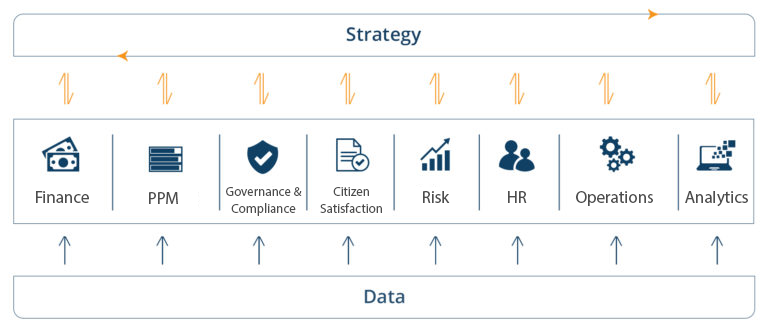
by Gail Stout Perry and Karl Magnus Horpestad, Corporater
There is a misconception that running a municipal government isn’t like working “in the real world.” But the truth is, running a municipality is similar to running a large complex organization in which the business has a wide variety of functional areas or sectors that align to an overarching set of goals (typically related to market share or financial growth).
Municipalities manage “businesses” in a variety of sectors - education, infrastructure, health, public safety, real estate, entertainment, compliance, sustainability, PR, marketing and many more departments are under the ever-widening umbrella of the local government. But municipalities can be more complex than conglomerates in that they must focus on multiple outcomes, not just financial results, such as keeping all the various agencies and departments aligned with policy while ensuring sustainability and achieving the performance outcomes that constituents and elected officials expect.
Issues from any of the departments often end up being dealt with on an ad-hoc basis, too often catching leaders and elected officials by surprise. This, combined with the movement toward greater transparency and accountability in local government have elevated the importance of the use of performance management in municipal governments. Of course, the value of using metrics to drive performance improvement is nothing new to any municipal leader who hasn’t been living under a rock for the past decade! Municipalities from all over the world have learned from the success of the CitiStat model. For those who aren't familiar, it is a system that primarily focuses on data collection and analysis and resembles the business intelligence (BI) systems that are used in major companies (and conglomerates) to collect and analyze data to gain insights into performance.
So yes, many municipals find value in using data and analytics just as their counterparts in the private sector do. But did you know that private sector has faced similar frustrations as municipalities in terms of moving beyond data analysis and connecting those data insights with achieving their desired outcomes? So, how do you close the gap between insights and outcomes? And how do you get your arms around your highly complex and diverse organization?
First, you must realize that there are two major categories of work between them that enables insights analysis and achieving desired outcomes. These categories are “planning” and “execution.”

Analyze
By analyzing your data (such as CitiStat), you find valuable insights. This is the first stop on the journey to achieving the bigger outcomes such as financial sustainability and constituent satisfaction.
Plan
Based on the insight you’ve gained, you need to plan how you will react to the insights. This involves initiative and task planning, assigning responsibility to people and departments, ensuring funding, setting a timeframe, and other activities which will prepare you for the execution phase. In other words, choosing which performance drivers to focus upon.
Execute
This is the critical phase that most analytics and planning systems lack today - an execution engine that tracks the progress of the execution, notifies people when tasks are assigned, provides early warning of delayed or underperformance, manages risks, and drive the plans through to completion.
Outcome
At the end of the day, it’s about achieving the bigger outcomes such as financial health, public safety, a sustainable environment, and constituent satisfaction.
Most well-run organizations have internal processes and frameworks for planning and execution. But how does a leader get his/her arms around all the moving parts across the entire organization to ensure alignment and accountability in executing toward desired outcomes? No doubt the work is taking place. But how are you managing it? And are you losing sleep at night worrying about unpleasant surprises?
If you are like many municipal leaders, you are juggling a tremendous volume of spreadsheets, documents, slide decks, and emails. To help manage the load, one might consider a business management platform, a software system that has three primary attributes:
1. ‘Business’ means it crosses the silos across multiple functional domains in your organization (the tactical layer in the figure below) and links them to the overall outcomes desired by the organization (the strategy layer in the figure below).

2. ‘Management’ means it supports the necessary functions and processes for all three management steps needed to ensure you achieve business outcomes: analysis, planning, and execution.
3. ‘Platform’ means it can be modeled to support the unique performance management frameworks which exist in your functional domains such as Strategy, Governance, Risk, Compliance, PPM, Quality, HR, and Operations.
Examples of communities that use a business management platform
Gwinnett County (Georgia) adopted a business management platform 10 years ago. At the time, Gwinnett had implemented an advanced process within its organization to address performance and align project execution with metrics and performance management. This brought along a set of complex challenges - chief among them was alignment. Gwinnett County was looking to align its projects with individual accountability and have them tied together with strategies. In addition, multiple metrics were cascaded throughout the county departments, but there was no single, consistent method for connecting and communicating overall performance.
Gwinnett County uses a business management platform to monitor and drive its processes and performance and has cascaded 60 scorecards across 13 departments, using metrics and projects that are further cascaded to individuals to create visibility and accountability across the organization and to enable Gwinnett to make data-driven decisions.
As with most organizations, Gwinnett continues to improve its management practices and is now in the process of setting up a new framework for organizing its planning and execution processes and is using a business management platform to model and enable the framework.
Another noteworthy organization is Bergen Municipality (Norway), which uses a business management platform as its main tool for any performance and management reporting, with more than 400 scorecards and 400 reports created by the system. Before implementing the platform, Bergen was using a manual form to align metrics with key initiatives, strategies, projects, and individuals. But it faced a challenge using manual methods: how to ensure alignment throughout the organization with more than 16,000 employees to ensure execution would occur in a consistent manner? The business management platform automated the process of prioritizing requirements and management resources.
As municipalities are facing greater challenges and performance demands, having the right tools in place allows staff to focus on the actions (drivers) that actually make a difference. Running a conglomerate, either a huge private-sector organization or a complex municipality, is a challenging job but with the right insights and levers, the outcomes will be easier to achieve.
To learn more about how a business management platform works or how other organizations are using it, visit Corporater's website.
About Corporater: Corporater is a global software company that empowers public sector and private sector organizations to evaluate, manage, and continually improve organizational performance by providing a configurable business management platform that adapts to a client’s unique business model, out of the box. We use our gains for social impact.
Authors: Gail Stout Perry, chief strategy officer & Karl Magnus Horpestad, senior solutions consultant
New, Reduced Membership Dues
A new, reduced dues rate is available for CAOs/ACAOs, along with additional discounts for those in smaller communities, has been implemented. Learn more and be sure to join or renew today!
